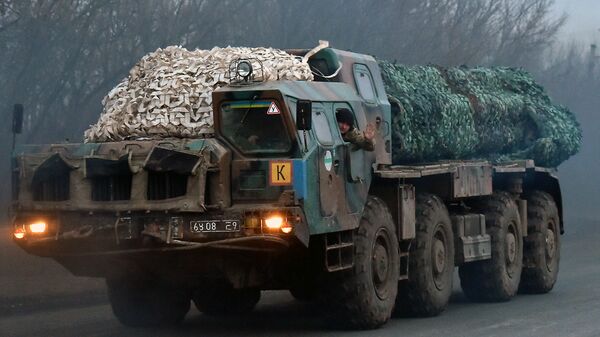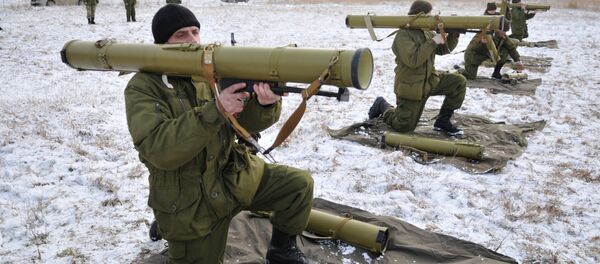On Friday, the press service of Ukraine's Security and Defense Council (RNBO) announced that the Ukrainian armed forces had successfully tested a new tactical missile.
According to RNBO First Deputy Secretary Oleg Gladkovsky, who supervised testing, the missile can be equipped with various types of warheads, including nuclear ones, and has a range of up to 300 kilometers. The Ukrainian media has since added that the missile itself is believed to be maneuverable, and that a full volley can be launched in only 38 seconds.
"Our military industrial complex, our scientists and designers were tasked with the goal of ensuring that Ukrainian missiles can be produced without even one component made in the Russian Federation. Our military industry together with scientists has worthily carried out this task. Our missile successfully accomplished the tasks set before it, and hit the intended target precisely," Turchynov said.
The Security and Defense Council has not offered details on the type or even the class of the new missile, but experts at the Russian Center for Analysis of Strategies and Technologies, analyzing photo and video material, concluded that the missile was launched from a MAZ-543 self-propelled launcher, which is the same vehicle used by the Smerch Multiple Launch Rocket System (MLRS).
According to Russia's Svobodnaya Pressa online newspaper, "the new missile, according to experts, is being developed by the Dnepropetrovsk-based Yuzhnoye Design Office," the premier developer of intercontinental ballistic missiles back in Soviet times.
"The control system," the paper explained, "likely uses a GPS-based inertial guidance and correction system, created by the Kiev-based Luch Design Office. Testing was presumably conducted using the standard Smerch rocket, with a new control module."
"Just how serious a threat are Ukrainian missiles to Russia, and will they be equipped with tactical nuclear warheads?" Svobodnaya Pressa asked, turning to several renowned Russian military experts for the answers.
Speaking to the paper, defense analyst Viktor Murakhovsky, a member of the advisory council of the Russian Military-Industrial Commission, suggested that the new missile is actually nothing more than an upgrade, albeit a substantial one, to an old Soviet system.
"The Ukrainians, in effect, have produced maneuverable ammunition for the Smerch rocket system, in service going back to Soviet days."
"Soviet missiles were based on the so-called inertial correction system, which provides for angular stabilization of the round at the boost phase, plus correction in distance through adjustments up to the separation of the round," Murakhovsky explained. "This system was able to significantly improve the accuracy and precision of the missile. Now, this system has been complemented via correction using satellite navigation."
Naturally Murakhovsky says, Russia will not permit Ukraine to make use of the military component of GLONASS. "And I'm not certain that the US has provided the Ukrainian military access to GPS. This means that the accuracy of the new Ukrainian missile is unlikely to be very high."
At the same time, the military analyst added, the touted 300 kilometer range of the new missile is, "by modern standards, very modest. Yes, the first Soviet-era Smerch MLRS had a range of just 90 kilometers; but later, warheads were transferred to missiles using a high-performance composite solid propellant, which reduced their weight and significantly increased flight range."
Unfortunately, "this solid propellant is not manufactured in Ukraine. Therefore, it will be difficult for the Ukrainians to increase the missile's range."
Asked by the newspaper whether the Yuzhnoye Design Office has the capability to create effective, contemporary short-range missiles, Murakhovsky suggested it was not designed for such tasks.
"Furthermore, it's not enough to simply design a missile. It must also be produced. Meanwhile, Yuzhmash, the leading Ukrainian enterprise charged with the production of rocket and space technology, has factually been left to die. Ukraine severed its military-technical cooperation with Russia long ago. This led to a situation where we stopped ordering rocket boosters from Ukraine, and other countries too have since abandoned the use of Ukrainian rocket technology. As a result, Yuzhmash is on the verge of bankruptcy, and its equipment has either been mothballed or sold off."
Producing a short-range missile, Murakhovsky emphasized, requires vast resources, including the existence of a production chain. "Since Soviet times, Ukraine has had a substantial portion of this production, but many components, aggregates and assemblies were received from Russia. Now, understandably, these channels have been blocked," and alone it will be very difficult for Ukraine to create anything qualitatively new.
Finally, regarding the missile's much-touted ability to carry a nuclear round, Murakhovsky noted that of course, in principle, it is possible. "But in this case Kiev would break the provisions of the Treaty on the Non-Proliferation of Nuclear Weapons, to which it is a party. Moreover, the Declaration of State Sovereignty of Ukraine dated July 16, 1990 clearly states that Ukraine must 'not take, produce or transfer nuclear weapons'. If Ukraine violates these agreements, they would immediately become a pariah state in the international community, and face the same fate as North Korea."
"In September 2014, the Ukrainian military demonstrated the 'Korshun', the first anti-ship missile of its own design. It was constructed at the Yuzhnoe Design Office, and in a fairly short period of time." Soon, it was discovered that the Korshun "was very similar to the Russian Kh-55 long-range cruise missile, produced at the Kharkov State Aircraft Manufacturing Company since at least 1986. Most likely, the necessary documentation survived, and came in handy for designers at Yuzhnoe."
As for the new missile, Konovalov noted that while it could actually be regarded as a modest success for the Ukrainian defense industry, "the Security and Defense Council's statements are always more about politics than about military-technological achievements and common sense."
Ultimately, Svobodnaya Pressa notes, it's one thing to successfully test such a system; it's quite another to actually put it into serial production, "and this is something that may take Kiev months, or even years, to accomplish."
"Of course, there is little good from the fact that our closest neighbor now looks exclusively to the West, and is working on plans for armed conflict with Russia. On the other hand, Ukraine is not in the nuclear club, and never will be. The US and Europe will not allow it – the country is too unstable, even if in principle, it could create its own nuclear weapons, especially tactical ones."
"In other words, Kiev will not equip their new missiles with nuclear warheads. And Russia is not afraid of the conventional ones," the paper concludes.






